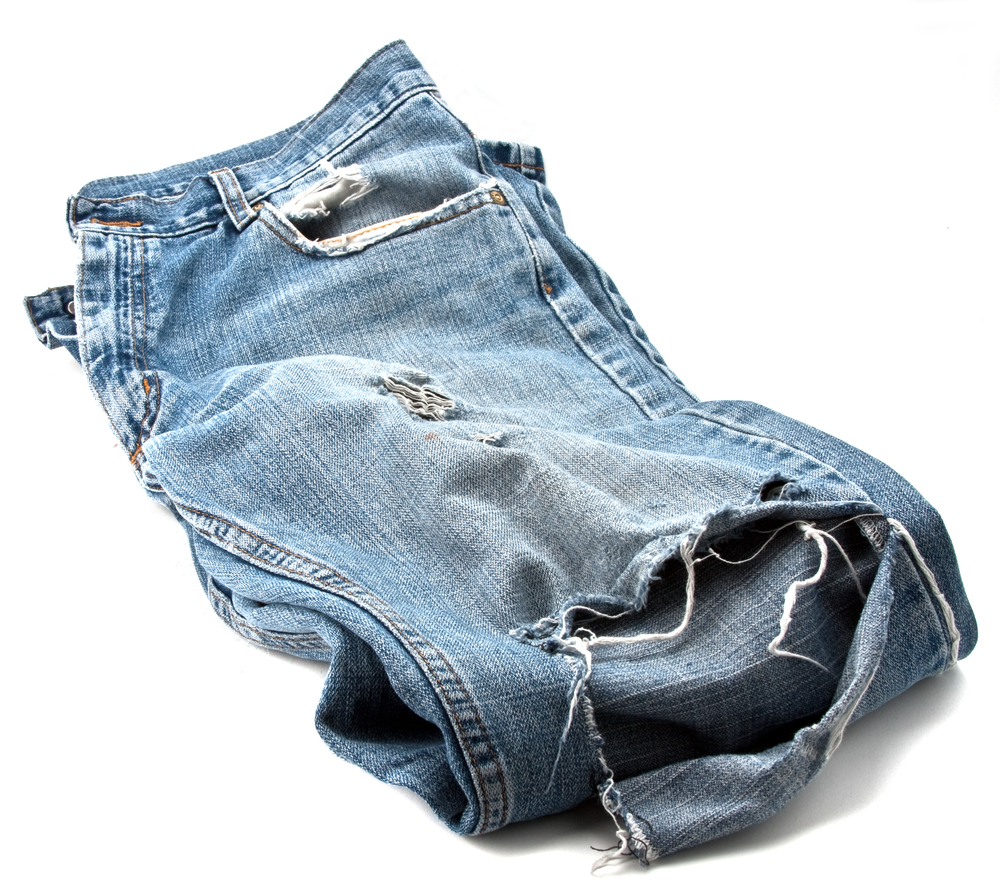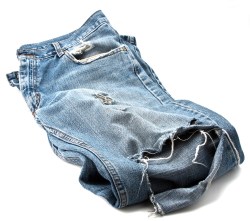Send your question to Umbra!
Q. Dear Umbra,
I wear jeans a lot, practically every day. When my jeans get a hole I patch them and wear them in the garden. But eventually they get too holey to wear even in the garden. What can I do with my old jeans rather than throw them out? Jeans don’t make good cleaning or pee rags like my worn-out cotton T-shirts. Can I send them someplace to be used as insulation for houses? Any other ideas would be appreciated.
Judith M.
Highlands Ranch, Colo.
A. Dearest Judith,
Jeans as pee rags seems like a new torture method. Let’s not go there.
I com-mend you (ha) for being so thrifty. And I’m sure you know, as our Greenie Pig recently confirmed, that you can make your denim last even longer by not washing it too often. But what to do when those dungarees done give up? You can mail them (and other denim cast-offs) to the Cotton. From Blue to Green program. Originally a campus-oriented recycling drive, the program turns your jeans into insulation, which is then used by Habitat for Humanity in hard-hit places like New Orleans.
Another thought: Since you’re into gardening, you could use your old jeans to make kneepads — which would protect subsequent pairs of jeans. You can also compost fabric, though it can take awhile to break down. Needless to say, crafty ideas abound for reusing denim — take a look at this list, for starters. Some of the items are in-jean-ious, and some will make you look like you stepped out of a Charlie’s Angels episode. I shall let you decide what suits you best.
Rivetly,
Umbra
Q. Dear Umbra,
What should I do with the stained, ratty clothes that the thrift stores can’t sell? I don’t want to send them to the landfill, but that is precisely what my local thrift store told me it does with donations that don’t sell on the floor. I only need so many cleaning rags. Does anyone recycle socks and T-shirts with too many holes to wear?
Allie M.
Corvallis, Ore.
A. Dearest Allie,
Yes, someone does recycle socks and T-shirts with too many holes to wear! The small but growing textile-recycling industry is a much better option than the local landfill. Please read my previous column on this exact topic, which offers excellent resources for learning more (if I do say so myself). I can only imagine the extent to which thrift stores are inundated with impossible-to-sell items, but I wonder if you could encourage yours to look into recycling. You could also look around for one that doesn’t dump unsellable goods. Larger charities like Goodwill and the Salvation Army, for instance, typically sell bales of scrap material, using the proceeds to support their programs.
We recycle only about 15 percent of our textiles in this country, but that number is growing: A few forward-looking municipalities have even started curbside textile recycling programs. Maybe you could get Corvallis on board!
Scrappily,
Umbra
Q. Hi Umbra,
I LOVE YOUR COLUMN. Grist is one of my all-time favorite websites and I’m so glad to read about the work ya’ll do. Yes, “ya’ll.” My friend and I buy most of our clothing from thrift stores and often find items that need a little sprucing or re-coloring. In order to make these items more socially acceptable, my friend uses Rit dye. Is this a harmful way to make items more colorful?
Fully Clothed
Chapel Hill, N.C.
A. Dearest Fully,
Thank you for the caps-lock praise. YOU MADE MY DAY. I would also like your thoughts on the spelling of ya’ll. I’ve seen it this way before, but I just don’t understand why the apostrophe is in the middle and not the beginning: y’all. It makes my head go all catawampus, it does.
Buying from thrift shops, whether by choice or circumstance, is a good way to reduce your impact. And as near as I can tell, Rit dye — which hit the market in 1917 and was named for an early investor by the name of Rittenhouse — is relatively safe. Of course, the fact that you have to wear gloves while using it, avoid drinking it, try not to inhale it, and so forth gives you a good indication that it’s not exactly benign. A company representative told me the ingredient list is proprietary, but according to the most recent Material Safety Data Sheets, the liquid and powder dye do not contain “substances defined as health hazards” or carcinogens.
While that information is sparse, it is somewhat comforting. Rit dye is probably no worse than the formaldehyde and other chemicals our clothes are often bathed in during manufacture. But it’s not as safe as, say, dyeing your clothes with all-natural sources like strawberries, artichokes, coffee grounds, or other things in your kitchen — give it a try! You’ll be the talk of Chapel Hill.
Boldly,
Umbra



